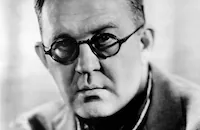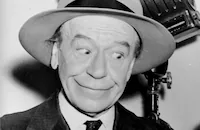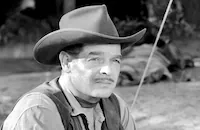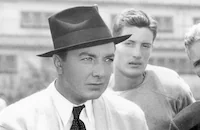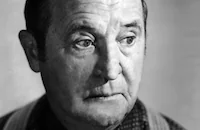According to Joseph McBride's tome biography
Searching for John Ford, Peter Bogdanovich
observed that when the director spoke of Abraham
Lincoln, there was "such an extraordinary sense of
intimacy in his tone, that somehow it was no longer
a director speaking of a great President, but a man
talking about a friend."
Now available on DVD from the Criterion Collection
is Ford's intimate valentine to the Great
Emancipator,
Young Mr. Lincoln (1939), a fine
slice of Americana that is best served with some of
Mom's apple pie. Starring Henry Fonda as the
titular character, Ford's film is less biography
than hagiography, structured around a story loosely
based on a real event in Lincoln's early years in
Springfield, Illinois, one that had the young lawyer
successfully defending Duff Armstrong in 1857 of
murder charges by referencing an almanac.
Young Mr. Lincoln touches upon several key
moments in Lincoln's life; his early romance with
the doomed Ann Rutledge; an awkward courtship with
society darling Mary Todd; the introduction of his
folksy style to the political stump; and the
pre-destined way in which Lincoln stumbles upon a
copy of
Blackstone's Commentaries, his first
exposure to the law, a discipline in which Lincoln
sums up simply and profoundly as "right 'n' wrong."
But what is most important other than the
plot--which is really a tranquil stream of anecdotal
episodes—is the way in which Lincoln's early life is
seen through our privileged perspective of knowing
what the man was destined for, that of serving as
the president who symbolically bore the sins of the
nation and bound up its wounds. In the final
sequence in the film, Lincoln walks to the top of a
hill amidst an approaching storm, a metaphorical nod
to the coming crisis between the United States.
(This sequence, shot on the Fox Studio backlot, was
a happy accident. A real thunderstorm was
approaching, and when the rain began to fall as
Fonda walked up the hill, Ford said aloud, "The
tears of the multitudes.")
Young Mr. Lincoln wasn't Ford's first take on
the 16th president. Lincoln figures prominently in
the director's silent epic
The Iron Horse, as
the inspiration, if not the guiding force, for the
Herculean task of building the transcontinental
railroad. It is a portrait of Lincoln the father of
modern America. Then the memory of Lincoln weighed
heavily on Warner Baxter's mind in Ford's
The
Prisoner of Shark Island (whose French title is
Je n'ai pas tue Lincoln, or
I Did Not Kill
Lincoln); Baxter plays Dr. Samuel Mudd, the
physician who was wrongly convicted of co-conspiracy
with J.W. Booth. (Mudd's name is still mud to this
day; so far, his descendents have been unsuccessful
in overturning his conviction.) Lincoln is also a
presence in
The Civil War, Ford's segment of
How the West Was Won (1962),
Sergeant
Rutledge (1960),
The Man Who Shot Liberty
Valance (1962), and
Cheyenne Autumn
(1964).
Intimidated by playing such an imposing figure, one
that was still very fresh in the American
conscience, Hank Fonda at first rejected the part.
"I didn't think I could play Lincoln. Lincoln to me
was a god," Fonda said. But he later changed his
mind, due in part to a meeting in which Ford
reportedly told the reluctant star that he would be
playing not "the Great Emancipator" but "a
jack-legged lawyer from Springfield, Illinois — a
gawky kid still wet behind the ears who rides a mule
because he can't afford a horse." As Fonda later
said, that quote was actually peppered with a
liberal dose of four-letter-words, best unprinted
here. Regardless of how he sold the part to Fonda,
Lincoln was a deity to Ford as well. According to
McBride, Lincoln is to Ford "the archetypal figure
of justice, a man who dispenses legal wisdom with a
priestlike humor, charity, and tolerance. He is the
forefather of the Fordian lineage of folksy, humane
judges and politicians that also includes Judge
Priest (from Ford's 1934 film of the same title) and
Mayor Skeffington (from 1958's
The Last
Hurrah)."
Honest Abe in
Young Mr. Lincoln was a mighty
different prairie lawyer from the one James Stewart
would bring to
The Man Who Shot Liberty
Valance, even though Ranse Stoddard and Abe
Lincoln have much in common, like a professed love
and respect for the law, especially where there is a
shocking lack of it. In a scene that is probably
fictional, Lincoln stands as the lone figure between
his clients and a lynch mob. It is a definition of
Fordian frontier heroism. It was also a scene that
triggered strong memories for Henry Fonda; as a boy
growing up Nebraska, young Mr. Fonda had actually
witnessed the horror of a mob lynching, an event
that influenced the famous liberal's politics.
Oddly enough, at first glance it seems that Fonda's
life-long friend Jimmy Stewart would make a much
better Lincoln. Stewart had the aw-shucks demeanor
going, and he was much closer to Abe's size.
Nevertheless, Fonda's flat Midwestern accent, his
puttied nose, and various tricks to make him appear
taller, such as wisely placed camera angles and shoe
lifts, make him Lincoln. Speaking of the Lincoln
nose, in his audio interview with his grandson Dan,
Ford claims that he didn't recognize Fonda the first
time he met him without the Lincoln make-up. But in
another interview with Fonda, the actor confirmed
that this was indeed typical Ford: a load of Irish
blarney.
There is a typical love affair going on between Ford
and the landscape in
Young Mr. Lincoln, only
it's not a landscape of craggy monuments or sweeping
valleys. It's a poem to the Sangamon River
(actually the Sacramento River in California),
well-worn country roads, and pioneering towns
covered with their first generation of dust. And it
is a love affair for Lincoln too. While he is
awkward and shy at the society dance with Mary Todd,
he is shown as a man in tune with nature, as he
soaks in his law books, lying on his back in the
grass, feet propped up high on a tree trunk. He
seems to be a part of the scenery as his gangly gait
rides a mule through knotty trees lining country
roads, while he appears to be a comic fool riding
the same mule past the houses and shops of young
Springfield. In his liner notes essay, Geoffrey
O'Brien writes, Lincoln's "location in space, his
relative distance from those around him, his
physical stance, his degree of comfort or
discomfort: these are constant reference points. We
can't take our eyes off him, and yet there are
moments when he is almost lost in the crowd."
Also present is Ford's love of simple, but
profoundly meaningful pageantry. Pie-eating and
rail splitting contests (Fonda actually splits one
in impressive time) bring together the community,
while parades of surviving veterans of the American
Revolution remind observers of their debt to those
that came before them. Then a tug-of-war contest is
staged in which Ole' Honest Abe cheats; he wins the
challenge by hooking the anchor of his team's rope
to a mule cart.
Young Mr. Lincoln arrived on the scene June
9, 1939, the year of Hollywood's golden year. The
same year saw the release of not only
Gone With
the Wind,
Gunga Din,
Mr. Smith Goes to
Washington, and
Ninotchka, but also
Ford's seminal Western
Stagecoach and his
other collaboration with Fonda,
Drums Along the
Mohawk. Even though it was obviously quite a
year of competition, only
Young Mr. Lincoln
had the distinction of becoming a major inspiration
for master Soviet filmmaker Sergei Eisenstein's
propagandistic classic,
Ivan the Terrible
(1944). And in an ironic twist that might have only
deepened John Ford's famous contempt for
intellectuals, the editors of the eminent film
journal
Cahiers du Cinema published "John
Ford's
Young Mr. Lincoln" in August 1970, a
much-debated article that proposed Ford's film as a
key work to study through the lens of semiotic film
theory.
Criterion's double-disc set features a new, restored
high-definition transfer of the film, and several
outstanding supplements on the second disc,
including two BBC productions,
Omnibus: John
Ford, part one of a profile of John Ford, and
the talk show
Parkinson: "Meets Henry Fonda."
There is also a radio dramatization of
Young Mr.
Lincoln, downloadable as an mp3 file, while Dan
Ford provides archival audio interviews conducted
with Fonda and his cantankerous grandfather. At
lastly, the DVD offers two must-read essays, "Hero
in Waiting" by Geoffrey O'Brien, and "Mr. Lincoln by
Mr. Ford," Sergei Eisenstein's 1945 essay originally
written for a proposed volume on Ford for the series
Materials on World Cinema History (Griffith and
Chaplin). Eisenstein ends his essay, "My love
for this film has neither cooled nor been forgotten.
It grows stronger, and the film itself grows more
and more dear to me."
For more information about
Young Mr. Lincoln,
visit
The
Criterion Collection. To order
Young Mr.
Lincoln, go to
TCM Shopping.
by Scott McGee




